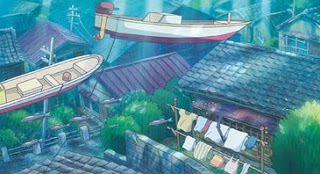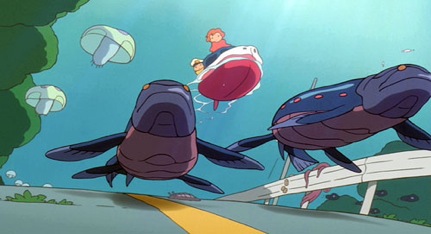An essay on
Gake no Ue no Ponyo
[Ponyo on the Cliff by the Sea]
Andrew Kandel, Swarthmore College, Class of 2015
"Ponyo" (崖の上のポニョ Gake no Ue no Ponyo) is a 2008 animated film by the well known Studio Ghibli, directed by Hayao Miyazaki. The film focuses on the love between a young boy named Sōsuke and Ponyo, a goldfish who becomes a girl, against the backdrop of a magical tsunami caused by Ponyo herself that strikes Sōsuke's idyllic coastal hometown. The land is flooded, creating a wondrous new underwater environment flourishing with life. The moon is drawn closer, and satellites fall from the sky like shooting stars. Although lives are threatened, nobody dies and there is no real destruction: rather than shots of devastation, the viewer is treated to beautiful underwater scenery. While the community has to pull together in the wake of the disaster, this only serves to strengthen it as the locals help each other in a festive atmosphere. Sōsuke even remarks that the refugees' boats look like a parade. The tsunami that wipes out the town may evoke initial terror, but its wake leaves a sense of wonder rather than one of loss, a revival rather than a disaster.
After the tsunami, Sōsuke and Ponyo go on an adventurous boat trip from Sōsuke's house to the senior home Himawari no Ie (Sunflower House). At 1:14:40, they encounter a mother, father, and baby casually out for a gondola ride with sunhats and parasols. They look ready for a picnic. Soon afterwards (1:17:28), a train of colourful flag-decked boats pass with rowers' cries of "Yoi-sa!" while en route to the Mountain Peak Hotel. Sōsuke remarks that "It's just like a parade!" and the festive atmosphere is, indeed, unmistakable. The leaders of the evacuation allow the children to go on to the senior home unsupervised, saying that they will pick up the seniors next. No sense of danger is acknowledged, nor is the possibility that the seniors were wiped out in the tsunami. This is, it seems, a tsunami without disaster. Meanwhile, the flood has transformed the landscape into something magical, a world flourishing with life, including fish from the Devonian era. Although the flood has not yet abated by the end of the film, it is strongly implied that it will recede into the ocean shortly, leaving no lasting damage.

Sōsuke's sunken hometown at 1:26:15. The water is clear, none of the buildings are damaged, the plants seem to have already adapted to their new environment, and the clothes are still on the line while fish swim by.
Image from http://www.ghibliworld.com/newsarchive.html.

Ponyo and Sōsuke pass above a pair of dipnorhynchi at 1:14:08.
Image from http://bananamondaes.wordpress.com/
At the Venice International Film Festival in 2008, Miyazaki addressed the tsunami in Ponyo, saying, "There are many typhoons and earthquakes in Japan, and there is no point in portraying these natural disasters as evil events. They are one of the givens in the world in which we live. I am always moved when I visit Venice to see that in this city, which is sinking into the sea, people carry on living regardless. It is one of the givens of their life. In the same way people in Japan have a different perception of natural disasters." (Sotinel)
We certainly see this in the reactions of the townspeople to the disaster: rather than despair, they band together to withstand the flooding of their hometown or even take the opportunity to go out for a picnic while they wait out a disaster that will, presumably, end. But Ponyo's refusal to acknowledge the real destruction and loss of life involved in a real tsunami makes the tsunami in Ponyo seem a very different phenomenon – a harmless, temporary transformation of the landscape from the mundane to the fantastic. Rather than a natural disaster, this is a sort of natural eucatastrophe and a cause for childhood excitement, like a snow day.